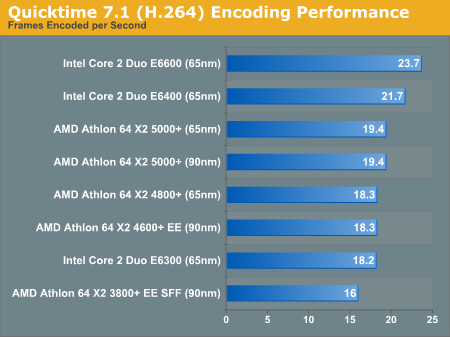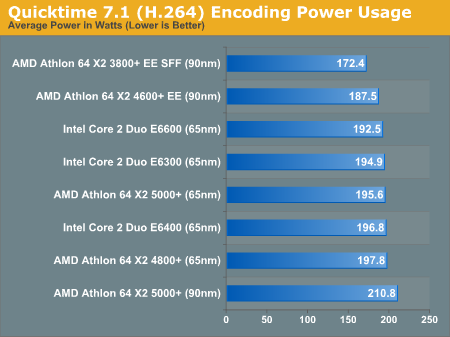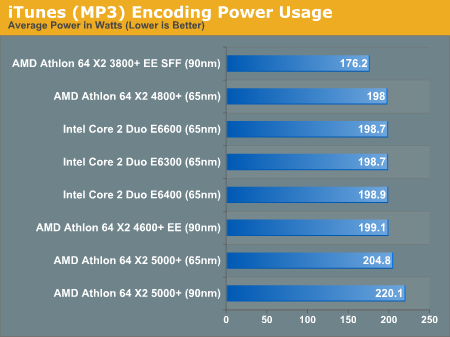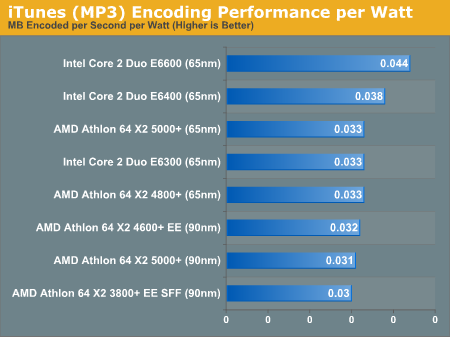AMD's 65nm Preview Part 2 - The Plot Thickens (Updated with Information from AMD)
by Anand Lal Shimpi on December 21, 2006 12:12 AM EST- Posted in
- CPUs
Media Encoding Performance & Power Consumption (Continued)
The standings don't change much in our QuickTime test, with Intel taking top honors. The 5000+ chips are tied for performance but the 65nm chip uses quite a bit less power. Performance per watt echoes the performance chart, but the 90nm 5000+ drops to the bottom, with everything lower than the 4600+ EE clustering close together.



Our iTunes test is the first place where we see a small difference between AMD's 90nm and 65nm cores, in this case the older core has an advantage of just over 2%. The highest performer is clearly the E6600, followed by the E6400. The E6300's lower clock speed puts it in between the X2 5000+ and 4800+.
Power consumption is the same old story, with AMD's EE SFF chip drawing the least power while the 90nm X2 5000+ pulls the most. The rest of the contenders basically use about the same amount of power.
Looking at performance per watt, once again we have the E6600 and E6400 out on top, and the Brisbane cores tie with the E6300 in the middle of the pack.













52 Comments
View All Comments
mino - Thursday, December 21, 2006 - link
RD580 is even lower than P965 ... NF i680 and NF 590 are both power hogs.They are not ideal (as well as 8800GTX) for power-comparison but they are BOTH pretty hot in their respective markets.
JackPack - Thursday, December 21, 2006 - link
Where did you pull that "90%" figure out of? If a PC is idling more than 90% of the time without going into standby or hibernate, the user is an idiot.Hardly any PCs operate at pure idle. No real-time antivirus scan, no file indexing in the background, no email autochecking, no IE7 open with at least one Flash ad, etc.
mino - Thursday, December 21, 2006 - link
Well, how would you like Your PC to standby(not to mention hibernate) while typing or listening to MP3's ???At these moments (most common usage of a PC BTW) the average CPU use is 1% to 5%.
... ;-)
mino - Thursday, December 21, 2006 - link
Sorry fo no reading the second sentence, the first one was too crazy to continue reading back then ... So"Wwhat is "pure idle" ? CPU is able to go between C-states in (micro-to-mili)seconds, How fast can you type?
AV checking? when you type? to check whether one is coding some exploit? :)
Backgroung file-idexing? no thanks, I prefer on-MY-demand search to on OS's demand.
Email-autocheck? done in 0.1s at 5% CPU used, once in 5 minutes...
IE7? no, thanks, not required for Windows Update...
Flash ad open? no, thanks, flash enabled only for reasonable sites or the ones requiring it(a few). Also, an usuall Flash is only up to 10% K8 core at 1000MHz
etc.
You may ask, why X2/C2D then when no background BS? Well, as of now I'm pretty happy with my Q1 install of Win2k on A1.66/512M/R9200/dualUXGA backed up by ~ 2TB NAS(with 3G P4C :). The system is more responsive than nearby mate's X2/1G with all that "necessary" bloat you mentioned.
Me having loaded 50+ webpages and 5-10 active apps a common sight...
mino - Thursday, December 21, 2006 - link
Now I figure, maybe, maybe, the average PC has become so bloated and unmaintained as to not even be able to put CPU's to Sleep states?I have not seen this except outrageously malwared machives yet. However my sample size may be unrepresentative a bit too much.
If it is so, to abandon PC and return to calculus at primary may be a good idea.
JackPack - Thursday, December 21, 2006 - link
That's not idling.Nice strawman, BTW.
mino - Thursday, December 21, 2006 - link
Well, wrote "90% of time" ... did not write how big the chunks of time are - they vary pretty much from tens of microseconds to tens of minutes.P.S. that post of mine from 10:19 was written before yours 10:13.
JackPack - Thursday, December 21, 2006 - link
...and AMD wants to accelerate their transition to 45nm? Maybe they have a magic lamp somewhere in their Sunnyvale office.Seems like the increase in L2 latency might be a contingency plan for GHz or more cache, in the event Agena doesn't meet its Q3 target.
Locutus465 - Thursday, December 21, 2006 - link
I upgraded to an S939 X2 earlier this year, so I'm going to be out of the serious upgrade market for a while (might pick up a better CPU or graphics card that's about it). So personally I'm waiting for K8-L and co-processors to see how things shake out. I do have to say I had hoped better from AMD, but after 3 years of dominance I think a stumble like this is just what they need to get them back on the war path of innovation.peldor - Thursday, December 21, 2006 - link
AMD's vision of coprocessors is 2009 stuff. You'll be out of the market a long time if you're waiting on that.